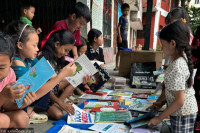Entertainment
To thine oneself be true
Four-hundred years since Shakespeare’s death and 200 years after diplomatic relations between Britain and Nepal were established, two talented citizens from both nations are collaborating to produce a Nepali rendition of the classic Hamlet, both in Nepali and English.
Rea S Mishra
Four-hundred years since Shakespeare’s death and 200 years after diplomatic relations between Britain and Nepal were established, two talented citizens from both nations are collaborating to produce a Nepali rendition of the classic Hamlet, both in Nepali and English.
Hamlet being a classic play performed the world over for centuries was brought to Nepal this time around by director Gregory Thompson and associate director Bimal Subedi. After being showcased in Bhaktapur Durbar Square in English on October 12, 2015 the play was then translated in Nepali to be showcased in Kathmandu.
Hamlet’s tale of intrigue and vengeance was staged for a span of a month at the Theatre Village, in Uttardhoka. The adapted play starred popular actors such as Divya Dev Pant (as Hamlet), Shristi Shrestha (as Ophelia), Kamalmani Nepal (as Claudious), Aruna Karki (as Gertrude), and Bholaraj Sapkota (as Polonious), among others.
Despite the fact that Hamlet is originally a British play, the Nepali rendition was seamlessly linked to Nepal’s own historical cornerstones, such as the royal massacre. The adapted Hamlet was presented with a shaved head and donning the white-a voluntary Nepali ritual that many young Nepali men partook in during the national mourning for the royal family. Even the British names were adapted to Nepali—Ophelia to Ojaswi, Claudious became Kamal Bikram, Gertrude to Gyaneshwori, Polonious as Pratap jung, Laertes adapted to Lalit Jung.
The hype around the popular model/ former Miss Nepal Shristi Shrestha playing Ophelia was thoroughly justified as she gave the famously deranged character the depth and nuance it deserved—despite her delivery lacking clarity at times. “There are many similarities between our history and this play; which is why I loved being a part of this production, as it was so easy to relate to,” says Shrestha.
Divya Dev, whose previous plays only ran for about a week or two, remarked the play required extensive practice and caused fatigue as the actors played the same role mentally and repeated the same lines over and over again physically. Despite this, both he and Shristi Shrestha described it as an honour to have been a part of the production. Moreover, the props were meticulously planned and placed. And the same could be said for the actors—some of whom played up to three characters.
With all the actors and actresses being outstanding, Divya Dev certainly stood out as exceptional. From the very beginning to the last, he was immersed in Hamlet’s insanity and internal dilemma. The rage he was able to portray when he finds out his step-dad poisoned his own father, the sadness when he sees his mother crying could be seen plainly through the actor’s eyes.
With comic relief placed here and there to balance the palpable tension in the play, Hamlet was certainly a play worth watching. Given the hype over the play among Kathmandu’s theatre enthusiasts, the hundreds who flocked to the shows walked away thoroughly enchanted for a change and this production was another testament to how far the Nepali theatre scene has evolved in the past decade. This production certainly looks slated to become a crucial cornerstone for future adaptations and original productions that are to come.
The play drew its curtains at the Theatre Village on Saturday and is slated to be staged in London at the end of the month at the Southbank Centre.




 15.12°C Kathmandu
15.12°C Kathmandu










